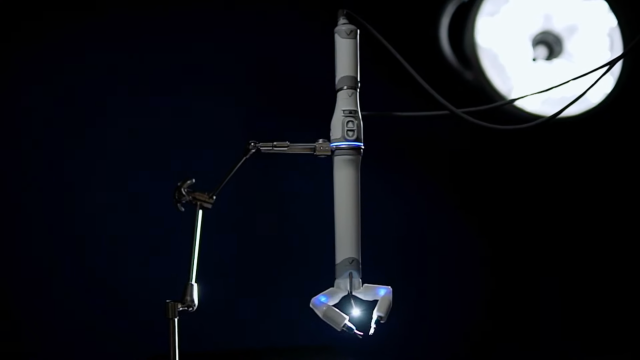Earth orbit is getting its own space doctor in the form of a small cyborg arm reaching out for the scalpel. A surgical robot is launching to the International Space Station (ISS) to test its ability to slice through human flesh in a microgravity environment.
The robot surgeon is part of NASA’s Northrop Grumman 20th Commercial Resupply Mission to the ISS, which is launching on Tuesday at 12:07 p.m. ET (Wednesday 4:07 AM AEDT) on board a SpaceX Falcon 9 rocket. The Cygnus spacecraft is packed with more than 8,200 pounds of supplies, including a tiny, two-pound robot known as MIRA (Miniaturized In-vivo Robotic Assistant) that allows doctors to perform surgeries remotely. Or in this case, when the patient is hundreds of miles away while floating in Earth’s orbit.
MIRA, developed by medical startup Virtual Incision, performed its first surgery in August 2021, assisting in a right hemicolectomy procedure by cutting a single incision on a patient. Now the mechanical surgeon is heading to low Earth orbit where it will be tested so that it can perhaps one day be able to perform surgeries on astronauts in space.
“Working with NASA aboard the space station will test how MIRA can make surgery accessible in even the most faraway places,” John Murphy, CEO of Virtual Incision, said in a statement. Thanks to a 2022 NASA grant awarded to the company, MIRA will operate inside a microwave-oven-sized experiment locker on board the ISS and perform activities that simulate those used in surgery like cutting through stretched rubber bands (an alternative to human tissue) and pushing metal rings along a wire.
The robot surgeon is equipped with two controllable arms that can hold tools like a pair of scissors. As it stands today, the cyborg arm can’t operate on its own, but rather through the help of a real-life human surgeon that can communicate with it. The company is working on making its mechanical doctor more autonomous so that it can perform procedures on its own.
Having a robot on board the ISS that’s ready to slice through human flesh may be useful for the future of spaceflight when astronauts might embark on longer duration missions to the Moon or Mars. “NASA has ambitious plans for long-duration space travel, and it’s important to test the capabilities of technology that may be beneficial during missions measured in months and years,” Shane Farritor, co-founder and chief technology officer at Virtual Incision, said in a statement.
